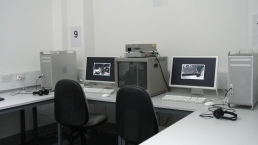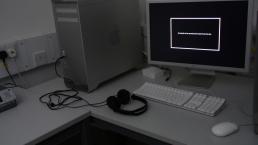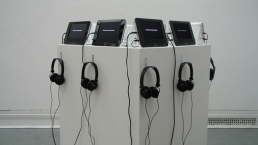Black Sand

My video installation Black Sand consists of eight single-shot one-minute sequences. The soundtrack of each film is heard on headphones and each sound-track consists of ambient sound mixed down with a voice-over. There is a written caption at the start of each film, linking the image directly to the narrative content of the voice-over.
This voice-over communicates stories of discontent, longing and heartbreak; creating an overall image of disenchantment. Some of these monlogues include quotes from the Roland Barthes’ book, A Lover’s Discourse: Fragments (trans. Richard Howard, Penguin Books, London, 1978), which has been of great interest to me. In this volume, Barthes has sensitively psychoanalysed the lover’s pathological condition and exposed the deep-seated neurosis that lies at the root of feeling-states such as ‘love’ and ‘desire’.
In Black Sand, the subjects are anonymous and the locations are non-specific because these narratives are universal and could apply to anybody, anywhere in the world. Each sequence thereby becomes a ‘video-postcard’ from an indeterminate subject-location.
Slavoj Zizek wrote in gaze and voice as love objects (eds. Renata Salecl and Slavoj Zizek, Duke University Press, Connecticut, 1996), “voice does not simply persist at a different level with regard to what we see, it rather points toward a gap in the field of the visible, toward the dimension of what eludes our gaze. In other words, their relationship is mediated by an impossibility: ultimately, we hear things because we cannot see everything.”
I have worked extensively with the cinematic convention of the voice-over and here, to paraphrase Zizek, I am interested in the way in which the voice-over can compensate for the blind spot of the image: in Black Sand the detailed poetry of the voice-over creates a specific emotional atmosphere which contrasts with the generic sterility of the single-shot.
In terms of installation, I have experimented with creating a long edit of all eight films and showing this sequence on a single video projector (see image above). I then experimented with an alternative set-up, where I showed all eight films simultaneously on eight computer screens.
Please click on the link to watch the Black Sand sequences.



I thought this latter installation was far more successful as it allowed viewers more freedom. In this situation, the viewer could choose which sequence they wanted to see, for how long, and since all sequences were looped, if they wanted to see the sequence more than once. They could then choose which sequence they saw next by moving to another computer.
At present, I have devised another solution for this video installation. My original intention was to show each sequence separately on a small nine inch LCD screen, and thereby to suggest the idea of a ‘video-postcard’. I researched solutions online and concluded that the best solution was to purchase eight portable DVD players. In my most recent exhibition I displayed these on a plinth. Each DVD player had one pair of headphones attached, which meant that only one viewer could experience each sequence at any given time. I think this contributed to a sense of intimacy and many viewers remarked upon the seductive intensity of the voice-over.


The following images are installation shots from Off The Shelf: An evening of words and images, The Cloisters, UCL (images courtesy of Martin John Callanan). I have since decided that the plinth is an inelegant solution and have decided to install the screens behind a fake wall instead.


The following images document the Slade Degree Show set-up, where I installed the eight DVD players behind 3mm MDF sheets to create a multi-screen video installation.



